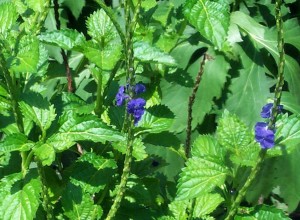I was working with BlueTang today, and at the location where we were working, there was some Blue Porterweed growing. Always looking to one-up each other, and one of my favorite foodie buddies, I asked, “Have you ever eaten one of the flowers?”
“Why the hell would I do that?” was his obvious response.
“They taste like raw mushrooms.”
“Bullshit.”
“No, like mushrooms…”
So I ate one, then another, showing him that they weren’t poisonous. He tried one. “I’ll be damned! Mushrooms!”
He paused then, “It never ceases to amaze me how you know all this stuff about what is edible.”
I replied with, “I missed a few meals when I was living out of my car, and didn’t like it. I figured there was a lot of stuff I could have been eating, so I learned.”
He laughed and said, “Yeah. You are like, ‘See that pile of dog shit over there? Under it is something that grows and is edible.’ Only you would know that.”
We laugh and go back to work.
I’m not the only person that knows this stuff, and I want to share as much of it as possible. One of my favorite sources for information is RidgeRunner. He has more free time than I do (and that is saying a lot!), and loves wild edibles as much as I do. We often get together and talk about what is edible, and what is GOOD to eat, two entirely different things.
For example, cattails are one of my favorites to eat when the opportunity arises. RidgeRunner agrees with me on this one, wholeheartedly. Young stalks, pulled out of the ground, will separate at the base of the step where it meets the root. The inner core of the bottom of the stalk is tender and VERY tasty. (Be sure to only harvest from safe waters, and also leave enough for future generations.)
I have a friend in the Asheville area of North Carolina that is an avid mushroomer. Thet guy can walk into a stand of trees and point to a dozen edible mushrooms…. and another two dozen poisonous ones.
Knowledge is the key to eating wild things, if you don’t know for CERTAIN what it is, DO NOT EAT IT!

From Eat The Weeds.com
How do you gain that knowledge? Trial and error was the original way, and it DOES work, but not recommended (see my note above!!!) These days, the best way is to go to a class. Here in Florida, Green Deane offers wild edible walks across most of the state at one time or another, and each season, you will find something different growing, and edible. Some are ok, some are great, but they are there. All it takes is the knowledge that our forefathers had.
There are also books, videos (again, Green Deane offers a LOT, and for free!), and dare I say it, talking with our grandparents. Both of my grandfathers have passed on now, but they grew up poor in some rather rugged country, in a time where there were no grocery stores. One of my grandfathers had well over a dozen kids in his family, and they all thrived, partly on wild edibles. I learned quite a bit from them, and didn’t consider it to be unusual to know what was growing wild that I could eat.
I will say to double check, and cross reference, any information you get. Remember, you are putting something into your body, that COULD cause damage…so verify your information! I prefer at least three separate sources that don’t refer to each other….just my two cents.
There is food out there for the taking, if we just learn what it is…
Peace,
db
As always, please “like” FloridaHillbilly on Facebook, subscribe to my feed, follow me on Twitter, add it to Google+, Pinterest, Linkdn, Digg, and/or tell your friends! The more folks that start behaving like ants, the fewer grasshoppers there will be left needing help.
Need something from Amazon (and who doesn’t)? I earn a small commission from purchases made when you begin your Amazon shopping experience here. You still get great Amazon service and your price is the same, no matter what.
Videos and pictures do not really help only a hands on would but no one around here to learn from sighs
Where is “here”? I’m guessing there IS someone….I have quite a few resources in the survival/wild edibles world, let me know your state/region, and I’ll see what I can come up with…
Haha definitely don’t eat it if you don’t know what it is, even if you’re lost and hungry.
I really need to start learning what’s edible and what’s not in my region. It’s such a valuable skill, one I’d love to acquire over time.
I brought seeds back from Miami to Pennsylvania some years ago. Got plants to grow, but they didn’t set seeds. Must need some specialized insects for pollination?? Anyway, porterweed got it’s name from the fact that it was used to flavor a type of beer called “Porter” (or the other way, whatever).
http://www.eattheweeds.com/blue-porterweed-bottom-up/
Using “green dean” as a reference, I’m surprised you didn’t include that link, rather than just the one to his website.